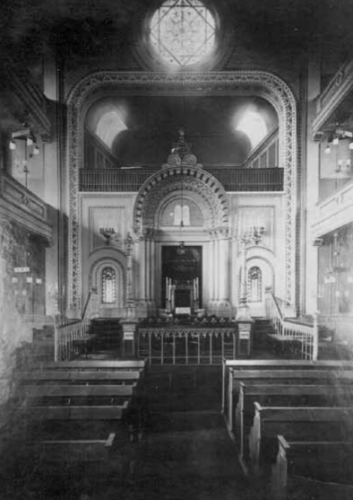Gleiwitz

First Jewish presence: approximately 14th century; peak Jewish population: 2,009 in 1867 (16% of the total population); Jewish pop. in 1933: 1,803
Jews were expelled from Gleiwitz in 1587, when the area was under Hapsburg rule. The forerunners of the modern community settled in the city in 1715; in 1812, the same year in which a synagogue and mikveh were consecrated with much fanfare, 180 Jews lived in Gleiwitz. Most local Jews were small business owners (two were landowners), because Jews were prevented from joining the guilds that would have enabled them to become craftsmen or skilled professionals. During the 1840s, however, with the advent of emancipation and the ensuing industrial development, young Jews from the surrounding areas moved to Gleiwitz in large numbers. In order to accommodate the growing population, the community built a large Orthodox synagogue with a double gallery, a dome and an eclectic mix of architectural styles; the inauguration ceremony (1861) was attended by many prominent government officials. The old synagogue was converted into a school building, and the community also maintained an elementary school, ran courses in the Hebrew language, an orphanage, a kindergarten, an old-age home, a soup kitchen, and welfare services for the sick and needy. After World War I, a branch of the Reich Federation of Jewish Front Soldiers was opened in Gleiwitz, as were two sports clubs (Bar Kochba and Hakoah) and four Zionist clubs. The community—with which 20 adjacent Jewish communities were affiliated—was home to several industrialists, 12 doctors and 14 lawyers. Although Gleiwitz Jews were protected by the League of Nations’ convention on minority rights until 1937, many had the foresight to leave. On Pogrom Night, the synagogue was set on fire, Jewish-owned stores and factories were vandalized and hundreds of Jews were detained in the community center; of these, 235 were sent to Buchenwald the next day, where at least six perished. Many local Jews left Germany after Pogrom Night, mainly for South Africa and Latin America. The remaining Jews were forcibly moved into designated “Jews’ Houses,” after which, in 1942, they were deported, in six transports, to the death camps. Several Jews committed suicide before the deportations, and approximately 40 others, all of whom were married to non- Jewish spouses, managed to remain in the city. After the war, approximately 200 Polish Shoah survivors established a new Jewish community in Gleiwitz, but nearly all immigrated to Israel after the 1967 Arab-Israeli War. The Gleiwitz museum houses a permanent exhibition on the history of Silesian Jewry.Photo: GermanSynagogues.com
Harold Slutzkin
Copyright: Pogrom Night 1938 - A Memorial to the Destroyed Synagogues of Germany/ Germansynagogues.com
Notes
Sources: The Encyclopedia of Jewish Life Before and During the Holocaust, Shmuel Spector [Ed.], [publisher] Yad Vashem and the New York University Press, 2001., Lexikon der jüdischen Gemeinde in Deutschen Sprachraum, Klaus Dieter-Alicke, [publisher] Gütersloher Verlagshaus, 2008.
Details
| Date Added | Jan 30, 2020 |
|---|---|
| Category | Residential |
| Country | PL |
| State | Silesia |
| City | Gleiwitz (Gliwice) |
| Exhibits | Pogrom Night 1938 - A Memorial to the Destroyed Synagogues of Germany |
Have additional information, photos, connections, or other resources to contribute?
Help Us in the race against time to time document Jewish history!







